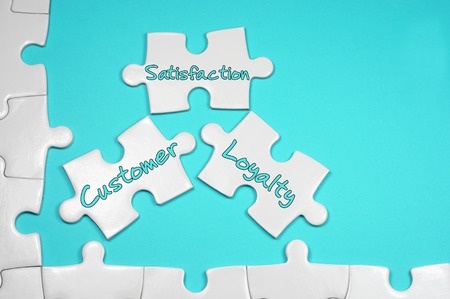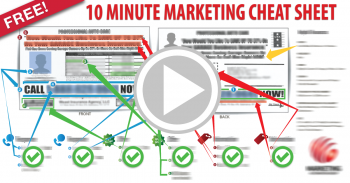Category Archives for Sales

A Powerful Lesson From My Mentor
Years ago, I learned something from my mentor that
has proven to be more valuable than most other things.
I’ve used this specific thought process to ‘fix’ many
businesses and get the cash flowing again rapidly.
Here’s this nugget of wisdom in it’s simplest form:
The amount of money you make is in direct proportion
to the number of offers you make.
That’s it, simple, yet profound.
In every instance, in every situation when I start working
with a client that isn’t hitting their revenue goals, all I
need to do is evaluate the number of ‘offers’ they are
making on a daily, weekly, monthly basis and right there
I find the problem.
So if you’re finding that you’re not hitting the revenue
numbers you’d like, ask yourself (and be brutally honest)
‘how many times a day am I making an offer to someone?’
Are you on the phone asking people for their business?
Are you running webinars to promote and sell your services?
Are you doing live presentations?
Are you emailing people asking for their business?
What are you doing to make an offer?
See, when you make an offer there’s only 2 things that can
happen, 2 and ONLY 2.
1. They can say YES, I’ll take it.
2. They can say No.
But even the ‘No’ will often times turn into a ‘yes’ later on
IF YOU’VE MADE THE OFFER IN THE FIRST PLACE!
Of course NONE of this can happen if you don’t make the
offer.
So today’s lesson: Make a SHITLOAD of offers, and you’ll
make a ton of money.
Being a man that practices what he preaches, I’ve got an
offer for you. Right now I’m offering to do no charge
strategy sessions for REAL business owners who are doing
more than 100k a year in sales and want to get to the 100k
a month level and beyond.
If you think you’re ready for some no nonsense, clear thinking
go ahead and sign up for a strategy session with me by clicking this link.
I look forward to talking with you.
Yours in profit,
– Bob
P.S. Clear thinking is responsible for more business success than
everything else combined. If you’ve become clouded or ‘stuck’ in
your business, then a strategy session with me might be the
exact thing you need to get ‘unstuck’ and moving again. Click here to schedule yours now.
Trends and Tips in Inbound Marketing
 Throughout my career as a small business owner, I had the same marketing and productivity questions that my clients ask me today. I have been there—and I know what you are going through. You work long hours, have a great product, but your revenue just isn’t enough.
Throughout my career as a small business owner, I had the same marketing and productivity questions that my clients ask me today. I have been there—and I know what you are going through. You work long hours, have a great product, but your revenue just isn’t enough.
To correct this situation, inbound marketing is a must—and it doesn’t end there.
Marketing process—what’s in a word?
What do I mean by inbound and outbound marketing? A lot of small business owners are confused about web lingo. Conversions, lead generation, inbound and outbound marketing are all terms used to discuss getting more customers for your business, and increasing your revenue:
- Inbound marketing: From a computer, or via mobile, the web is usually the first place people look for information about goods and services. Your website is a critical piece of your marketing strategy. Inbound marketing attracts people already interested in your topic, product, or process. By offering informative blogs, tips, and other fresh data, your website works to convert website visitors to clients. To do this, your website should consists of search-engine-optimized (SEO) content, design, and keywords.
- Outbound marketing: Outbound marketing also helps you fill the top of your sales funnel. Think of the traditional methods, like cold calling, email campaigns, business and client networking, advertising, and referrals. These are important tools that may be more appropriate for your product or service than inbound marketing.
- Lead generation: Inbound and outbound marketing work to create active leads, or potential clients.
- Conversion: The process of turning an active lead into a paying customer is a conversion. For some businesses, conversion may take forms other than making a cash sale.
The importance of positioning
For you to allocate resources to marketing strategies, it is important to know your position—in the market, in the business lifecycle, and in your industry. A big part of my work with clients is helping them see their position, as well as what direction they need to go to achieve their revenue goals.
Once you have the bigger picture, you can drill down into techniques to help your bottom line. A super report from Hubspot offers marketing strategy information from the last half of 2015. Some key points of the report include:
- Inbound marketing is the top tactic for companies and small businesses. For companies with between one and 200 employees, vigorous use of inbound marketing and web strategies builds their brand and profile and keeps marketing costs down. Larger companies with deeper resources tend to employ inbound and outbound strategies more evenly.
- Small- and medium-sized businesses are growing—and looking for cost-effective ways to increase leads. But the priority is on turning those leads into paying customers. For entrepreneurs, you have to be able to measure the return on your marketing dollars—and prove your ROI for the budget spend.
- Inbound marketing works across industry, including non-profit, B2B, and B2C. Traditional outbound marketing methods cost more and achieve less ROI when compared to inbound marketing.
- The creation of inbound marketing content, like blogs, articles, whitepapers, and tip sheets is moving out of the business and into the hands of freelance writers and agencies. This makes sense as lean marketing and production strategies call for the right people doing the best job. As I have said before—make sure you are doing the job only you can do. When appropriate, outsource the responsibilities better suited to others, like content creation.
- Prime marketing strategies have already shifted. More than 55 percent of businesses who earned higher ROI on their marketing budget in 2015 say paid advertising, whether in broadcast, print, or social media, is the most overrated marketing path at present.
- Successful marketing means using both CRM and marketing automation systems.
You have a lot of leads—and then what?
With the rush to generate leads, some entrepreneurs forget to close. I am a big fan of marketing automation and CRM software, to identify, nurture, and convert leads. When marketing and sales teams are coordinated, the same software helps me maintain those clients and fine-tune my services to better obtain and serve customers. Internal service level agreements (SLAs) define responsibilities and outcomes for both groups.
Whether your marketing and sales teams are sizeable, or small, cooperation is fundamental to business growth and success. I work every day with entrepreneurs that have misaligned marketing and sales priorities. We explore ROI on all marketing efforts, and create the right plans to make sure your inbound marketing ultimately brings in the revenue you want.
When you have a question about marketing automation, or you need someone to reboot your marketing strategy, call me at 585-633-7563.
Yours in profit,
Bob Britton
Holiday Sales? Bah Humbug!
Okay—everybody loves a sale. But if you are depending on deep discounts to sweeten your business bottom line this season, think again.
Black Friday sales are legendary. Did you fight crowds to score a big screen television from Walmart for a 75 percent discount last week? “Black Friday” used to refer to a blockbuster shopping day that boosted business owners into the financial safety zone. But now there is Black Friday, Small Business Saturday, Cyber Monday—and a whole lot of discounting in the weeks leading up to Thanksgiving, and after.
Consumers now expect super sales throughout the holiday season. So everyone expects to pay less for whatever you have to sell. As an entrepreneur, does this sound like a great way to make money?
My business is doubling—if not tripling—the revenue of my clients. I work with entrepreneurs in all kinds of businesses. Some are well-established, while some are start-ups. As a small business owner several times over, I have seen my own businesses struggle and then thrive. So I know what it takes to succeed—and it is not the magic of the holiday discount shopping season.
Can you buck the holiday discount trend?
Outdoor outfitter REI did not open on Thanksgiving—or on Black Friday. Instead, the retailer closed all 143 of its stores and put a “gone fishin’” banner on their website that read, “We’re not here. Today we’re closing our doors…We hope you’ll join us outside today. You can still shop our site. We’ll start on your order first thing Saturday morning.”
While other stores pushed back on Thanksgiving openings, REI took it the extra mile. But consider this:
- REI is a lifestyle brand.
- REI is not making most of its money from mass merchandising. Unlike big box stores, REI has a somewhat exclusive niche market.
- If you chose not to join REI outside, you could still shop its website.
While only overall holiday sales numbers will tell—it is possible REI may have found a way to market its lifestyle message in a powerful way.
Black Friday, for most retailers, is about dropping prices on inventory low enough to attract bargain hunters. For many small business owners, if you do not offer rock-bottom prices, shoppers shrug and go down the block to another store, or big box that does. REI opted out of that traffic. Black Friday, or holiday discount—cutting your profit to bone is not going to boost your revenue.
What kind of customers are you looking for?
One of the first mistakes made by a lot of small business owners is to try and compete on price. Sure, you might get a few more customers, but they are the wrong kind. Bargain hunters are not loyal, and you cannot make a living—let alone a million dollars—offering bargain basement prices, unless you have an unusual product, or a high volume business.
In a LinkedIn blog post, Michael Silverstein, Senior Partner at Boston Consulting Group (BCG) writes, “Black Friday shoppers are your worst customers. Fire them and concentrate instead on your best customers.”
What does he mean?
He means you need to attract loyal customers—not high volume foot traffic looking for close-out prices. Your target is the client or customer who shops your business, or uses your services, throughout the year, not just when you are running a promotion. How do you identify these customers and keep their business?
- On the data side, use marketing automation and other reports to identify your loyal, repeat customers.
- Price your products and services so that you are making the profit you need to thrive. Evaluate your customer journey to ensure customers are getting a value proposition that equals the money they spend to patronize your business.
- Cater to clients who do not quibble about your price, but who appreciate your product, and the extra service they receive as a result.
- Develop programs and processes through which these clients are recognized and rewarded when they use your services.
- Take big advantage of digital tools like apps, and social media, to engage followers on channels like Facebook or Twitter. Keep your brand and profile fresh, and offer deals you can afford to those who you really want to attract.
Plan now and stay ahead
Thinking ahead helps you stay ahead. How can you make your business easier to find? What tech is right to manage client communications and promote your product? How can you meaningfully connect with your customer base to learn their needs and meet their desires?
Stay ahead of the curve to ensure your customers feel good about paying a price for your product that keeps them happy—and you earning the right revenue.
Constant stress and a minimal income keep you from the success you deserve. When you want to kick-start your business and marketing strategy, I hope you will call me at 585-633-7563.
Yours in profit,
Bob Britton
What is the Value of Buzzwords to Small Business Owners?
You have seen them, heard them, and used them. So have I. Buzzwords—there are a lot going around. Buzzwords are phrases that are shorthand for something meaningful in the culture at the moment. Harvested from television, thought leaders, politics, and the world at large, buzzwords are often a fast way of saying something more complicated.
Every so often you see an article listing the top ten or 20 most overused buzzwords. It is an easy, entertaining topic. But business buzzwords, whether overused or not, provide reminders of valuable ideas that could help your business.
Thinking outside the box and that kind of thing
Old and new, buzzwords have something for everyone. My job is to work with entrepreneurs to help them create value. Value is a big buzzword—but also the perfect word to define why someone should want to buy the product or service that someone else is selling.
Let’s take a look at some buzzwords of note, and what they might mean for you as an entrepreneur:
- Win-win: This is a great phrase, which has been around a long time. It rolled into the culture with the alternative dispute resolution (ADR) movement, and techniques like negotiation, for people to get what they want without bankrupting their businesses through litigation. For the entrepreneur, win-win is all about building the product someone wants, and charging a fair price for that asset. Too often, small business owners develop a great service, and charge too little. Sure, you have customers, but selling at a perpetual loss eventually stifles or destroys your business. Be fair—to yourself, and others. Win-win—a great product or service sold at a profitable price—is something you should always aim for.
- Core-competency: Thrown around a lot, especially in tech and human resource fields, core competency is an important word for the small business owner. Time and again, I ask my clients what they want to be doing, and I work with them on what they should be doing as the owner of their business. Way too often, they spend their time on tasks that could be done by others. As an entrepreneur, you must tend to your core competency—i.e., the work in your business that only you can do—and delegate the rest.
- Think outside the box: This old term was practically a mantra for an incoming generation of innovators, tech talent, and business owners. For entrepreneurs, thinking outside the box is not a buzzword—it is a necessity if you want to stay relevant in the marketplace.
- Storytelling: Although it is a new buzzword, storytelling is far older than the marketing industry. Storytelling is all about another buzzword, engagement. Humans are attuned to narrative of any length. For example, case studies are storytelling. The kind of engagement created by storytelling helps you explain your products and services, build a solid customer base, and draws your clients into an ongoing relationship with you and your brand.
- Big Data: The term Big Data is often used by marketers telling you that you need more Big Data to know how to sell to your customer. But, Big Data is actually just a lot of information that we now have the technology to capture. To use Big Data, you have to be smart and know what data you really need—and how it can help you. I work with marketing automation and help my clients fine-tune their data needs, in order to personalize and enrich the buying experience of their customers.
- Millennials and Boomers: Some buzzwords that describe your consumer audience are Millennials and Boomers. The Boomers were born after World War II and are pushing big changes in health care, retirement, and other services. Millennials were born between 1982 and 2004. These young adults grew up with tech and represent a strong market segment for goods and services. Strangely, no one talks much about the so-called Generation X, individuals born between about 1961 and 1981. Growing up on the cusp of the technology boom, Generation X’ers are in prime purchasing years and should not be ignored.
- At the end of the day: Pithy but perfect, at the end of the day, is the goal of your business planning. Always understand the bigger picture, your goals, and how much money you need—and want—to make from your small business enterprise. With no horizon line, you have no idea where you are going. Create structure, get advice, and adjust your business goals as you, and the economy, change.
Making bank. It means earning a profit. When you want to make more money by working smarter not harder, call me at 585-633-7563.
Yours in profit,
Bob Britton
Signal or Noise? How Do Your Help Your Customers Choose You?
 You have a terrific product or service—and a lot of competition for the business. How do you help your target customer choose you?
You have a terrific product or service—and a lot of competition for the business. How do you help your target customer choose you?
My business is helping you identify, attract, and land the customers you want, to make the profit you need. As a small business owner, I know what works, and how to use marketing technology to steer business your direction, and keep it coming.
But when it gets down to it, how do you help your client hear your message, and understand your brand, through all the noise? It is not as hard as you think.
The dynamics of choice and marketing
A lot is written about the psychology of choice. Drill into the topic and you’ll find research looking at why people make the choices they do.
Understanding why people make choices is important. As small business owners, we want to know how to influence choice to get more business. Poor marketing and product lines mean your premium clients go elsewhere.
As a consumer, you know what it takes to convince you to buy. Taking that perspective is important when thinking about how to sell to your client base. Consider these points about the experience of choice:
- Choice: It is important to do what you do best. If you sell one product, or one type of service, you need to be the absolute best and understand that you are working in a niche market. In a TED talk, author Malcolm Gladwell talks about choice—and spaghetti sauce. The take-home point is that there is no one kind of human, so offering few products, or services, could be a limiting factor to your business.
- Too much choice: Plentiful research bolsters the belief that too much choice is not a good thing. Offering a dizzying array of information, products, or services is just that—dizzying. Chances are good you will land a customer if you have a lot of choice—just make sure the choice is presented in a way it can be consumed. Design your website with filters, make auto-suggestions, enable reviews, and offer pages with a limited number of products, to create a pathway to purchase in digestible bits.
- Bias and other fine qualities: Your client approaches your business with pre-conceived ideas. How you present yourself, or your product, plays to their needs, fear, and identity. Humans place inordinate weight on the first information they receive about a person, place, or thing. If a good friend liked your restaurant, your new customer is predisposed to like it, too. If a client reads a negative review of the service you sell—you need to work harder to overcome that bias. If a customer is in need of basic information, your knowledge of your product—without an initial sales attempt—gives you a chance to create the image of a knowledgeable, trusted ally instead of a pushy salesperson.
Sales work is mostly psychology, with products mixed in. Know your customer, and know what you are really trying to sell.
To get to the sell, start at the beginning
Most people can sell something once. To profit and grow your business, you have to meet the needs of your customer repeatedly. Marketing hype has its place, but the bottom line is that you have to understand your business from the viewpoint of your customer.
There is a well-known story about the angel investor who kick-started Apple. Everyone starts somewhere and Apple founders, Steve Wozniak and Steve Jobs, originally worked out of a garage. Their first investor was Mike Markkula. As the story goes, Mr. Markkula also wrote a three-part marketing platform that continues to serve this very successful company.
The three mandates written by Mr. Markkula in 1977 remain effective and include:
- The quality of empathy: “We will truly understand their needs better than any other company.”
- The ability to focus: “In order to do a good job of those things that we decide to do, we must eliminate all of the unimportant opportunities.”
- Recognition of people to impute: “People DO judge a book by its cover. We may have the best product, the highest quality, the most useful software etc.; if we present them in a slipshod manner, they will be perceived as slipshod; if we present them in a creative, professional manner, we will impute the desired qualities.”
Take what we know about the science of choice, combine it with rock-solid marketing philosophy, and a great product, and you are on your way to small business success.
By understanding your own business, you can help your customer make a choice that benefits both of you. When you need help understanding the bottom-line of your business, call me at 585-633-7563, I can help.
Yours in profit,
Bob Britton
Technology and the Traditional Business Model—Does it Work?
Do you have a great idea? Do you think it will sell? How do you produce, market and manage your product or service? And how can technology help you? These are all basic questions that challenge every small business owner.
I got my start in small business with an auto repair shop. Plus, I have always been a computer geek. Along the way, I put the two together, and with a lot of hard work, I built businesses with revenue in the millions—by combining traditional business concepts and technology.
Small business owners and tech
A lot of small business owners are dedicated to delivering old-fashioned value and service to their customers. I work with a diverse group of clients who come to me when they have tried everything to get ahead, and are either falling behind, or just not achieving the success they want. I know—I’ve been there.
For me, a turning point arrived when I began to deeply understand the customer lifecycle, not just the single sale. By adding technological solutions to my traditional understanding of business concepts, I achieved success. And now I work hard to offer that opportunity for financial success to each small business owner I work with.
Technology, when used correctly, can help you allocate your time better, offer greater value, save money—and make you money. I use appropriate tech to create personalized, high-touch marketing campaigns and back-office tools that build my brand and extend my reach.
Trends in marketing tech
For me, a high quality customer relationship is a key differentiator. I want my clients to know they matter, and that I value their business. A lot of the time, my go-to method for personalized, old-fashioned client care is technology.
In 2014, Salesforce, a cloud computing company, sponsored a Forrester report on one-to-one, or personalized marketing. The survey queried more than 150 marketing decision makers in a variety of businesses, including leisure, retail, healthcare, financial services, and others. Trends identified in the report include the following:
- Consumers are more savvy than ever about services and information available to them through information technology. Personalization technology has not evolved as quickly as customer ability to use, and manipulate, their buying experience.
- The capability to create an individualized view of customers impacts the ability to orchestrate a helpful or successful customer journey. This means maintaining continuity during the customer experience and creating multiple real-time touch points during which to make attractive offers.
- Many companies are more focused on customer, or client, acquisition than they are on personalization. This more traditional thinking comes at the cost of the increased sales and conversions that can result from improved personalization techniques.
- Big data overwhelms marketing decision makers, making it difficult to create effective, automated, personalized marketing campaigns.
- Effective sales teams are more than three times more likely to use sales analytics than lower achieving sales units. Top teams are heavy adopters of high tech.
- High achieving companies are 3.5 times more likely than lower performing companies to view sales as the responsibility of the entire organization.
Together, old fashioned customer service, and meaningfully deployed marketing automation are critical to the future success of small business entrepreneurs.
Trends in IT for entrepreneurs
In the back-office, there are IT trends that business owners cannot ignore. Consider these points about small businesses and technology from the Harvard Business Review:
- Use appropriate spreadsheet, and financial, technology. Free resources on the internet may not provide the specialized solutions you need to track and drill into your business metrics. Conversely, enterprise architecture is not usually needed by small business owners.
- Appropriately sourced cloud-based storage and SaaS can save entrepreneurs on multiple fronts.
- One quoted expert notes, “SEO-optimized web sites, blogs, and social media are often the center of small business marketing programs. Combining them with a database or sales automation system to build brand and awareness makes small businesses much more open to the world.”
The model of traditional business has changed, but not traditional values. Do you have an unbeatable offer? Do you have the right technology and workforce in place? How about your business plan? When you know you can succeed, but you do not know what to try next—call me, I can help. My business goal is to make you a millionaire. You can reach me at 585-633-7563.
Yours in profit.
Bob Britton
Is Your Sales Team Costing You Business?
Every sale counts to a small business owner. You train your team, you fine tune your product and marketing, and you are doing okay – but not great. One day a friend mentions that he called your business but was stuck on hold forever. Or worse—he called and your sales representative was not interested in doing business. What gives?
If your sales team does not recognize one simple fact, you need to make some changes. And the fact is this: no one calls a business unless they have a need.
Offer solutions—not a stand off
Earlier in my career, I needed some marketing help. I worked with a company, set up an account, and got things moving. I realized that I did not have my content lined up, so I called the company to let them know I was holding off on my campaign for a few weeks.
In two or three weeks, I was set, and called to trigger the services I set up. The sales rep said my account was cancelled because I had postponed. When I asked if I could reactivate, maybe pay a small fee, the answer was no, my account was cancelled.
Anyone reading this is shaking their head. That blew my mind. Not only did this company not want my business—they argued with me about it. Even after the discourtesy of cancelling my account, I would have paid a fee to get going again. In effect, I was turned down twice.
Never do this. Obviously, I took my business elsewhere. And, needless to say, that company never got a good referral from me.
While the attitude of this sales rep—or maybe the entire company—was way off, there are times when a business does not recognize the signals that a customer, or a client, is ready to buy.
Sales signals—and what they mean to your success
Some entrepreneurs still try to get ahead with hard sales tactics. They employ tricks and tips that push and prod a customer into buying. While you can make a sale this way, it isn’t likely this customer will feel any loyalty to your company. And customer loyalty is one of the keys to ongoing business success.
My job is helping small business owners create and enjoy success. Whether talking about marketing, organizational planning, or business automation, I help business owners recognize and build relationships that work—through effective sales, business structure, and technology.
A big part of my job is helping entrepreneurs cultivate a clientele willing to pay premium prices, for high value, and good service. Success depends on repeat customers who enjoy how they are treated by your business.
Building a sales relationship with a prospective lead takes work and recognition of what signals an interested customer. Consider these points:
• Customer interest: I said it before, and I will say it again. No one is calling your business unless they have a need. On a sales floor, or on the phone, you need to find out about their need. You may—or may not—be able to offer the solution they want, but first understand that anyone who contacts your firm, or your shop, has a need that led them to take the effort to contact you.
• Reward customer interest: When someone calls or contacts you, reward them by listening carefully to what they are saying, and how they are saying it. Your goal is to build a relationship. This means active listening. Be intent on learning their need, parameters for their solution, budget, and timeline. With occasional additional questions—learn everything you need about their problem, so that you can offer a good solution. This means you never interrupt them to insert a sales pitch.
• Watch for signals: The best sales people are those who understand tone and body language. With enough experience, you, and your sales team, can recognize when a customer is signaling they want more information, want to buy—or that that they are not interested. When a potential customer is avoiding eye contact with you, browsing, and generally looking—express interest in them, but do not crowd or rush them. If a client calls about a product, or a customer starts looking carefully at an item—that means interest.
• Offer solutions: On the telephone, in person, or online—respond to the need identified by your potential customer. Once you know their concerns, put together solutions, let them know how that might work—and what that could cost. Work with their response and remember reciprocity is essential to a successful sales environment. Ensure your sales team understands anyone who contacts them is a potential customer. Even leads who do not buy from you today could return next week because they remembered your helpful attitude, information, and interest in their problem.
Sales are critical to small business success. Train your sales team, and fine tune your sales behavior to ensure you are building customer relationships that pay off today—and down the road.
When you need help with marketing, sales strategies, or using marketing automation to nurture client relationships—call me at 585-633-7563.
To your success.
Bob Britton
The Art of the Telephone Sales Call: Always Be Closing
When you know where you are going with a sales call, the chances are better that you and your client will get there. How? It’s as simple as ABC—always be closing.
Companies of all sizes are shifting from field sales to internal sales teams that are able to scale quickly to a new project or prospect. You and your sales department need a script and a structure to keep telephone sales productive.
As an entrepreneur, you are the face and voice of your business. You must have the awareness and ability to take advantage of a business opportunity whenever it calls. And that call may be tomorrow morning.
Making the connection: internet to telephone
Social media keeps your brand fresh and your name in play. While LinkedIn increases your potential sales pool, it does not make the sale for you. Regardless of your industry, each point of contact—social media, direct mail, email, or telephone call—adds to the perception of your company in the mind of your client.
Email and telephone calls are the primary points of contact for targeted sales leads. Before you pick up the phone, be certain about these points:
- Know who you are calling: Do your homework before you dial. Know who you want to talk to and why. Use LinkedIn for personal research, and the internet for business background. Know as much about your lead, and his or her business, as you can. Whether you make a cold call, or a scheduled sales call—make sure that your contact knows you are tuned in to them, and their business issues.
- Know your own business: Before you make the call, take stock. Use a headset to free yourself up to physically move during a conversation. Be familiar with your current business numbers, your vision, what you need from the call, and what you want as a result. Take time to refresh your business vision and your confidence—it improves your odds for success.
- Make sure you can talk the talk: Understand and appropriately use the language of your industry. Sale calls sometimes falter when reciprocity cannot be created through the use of common jargon, topical news, industry trends, and relevant stories.
- Have a plan: “Winging” a sales call does not work. While you may strike gold from time to time in an informal sales setting, you make more money when you take the time to make your plan. Sketch an agenda, unique points about your prospect, and your own market differentiators. Imagine the conversation, walk through possibilities, and see yourself closing the deal. If you do not have a process in mind when you make a sales call, you leave money on the table.
Making your best call
Service and sales calls are lifeblood for a small business owner, and they are easy to mess up.
When you have a good lead, make the most of it. When you pick up the phone, make sure you remember these tips:
- Smile: Why does it matter if you smile on the telephone? Including endorphins, smiling boosts other neurotransmitters that mediate mood, blood pressure, and heart rate. You experience a boost in confidence and greater overall relaxation. Even if no one sees it, set the stage for your sales call with a smile.
- Connect: When speaking with a prospective client, let them know they are your most important priority. Because of your research, you know something about them, and their business. Comfortable, confident rapport heightens your credibility.
- Learn: Listening is a key feature of a successful sales call. Ask open-ended questions that reassure, and encourage your lead to discuss their company, and their business issues. Explore without pushing your own solutions. Information gained while actively listening to a potential client gives you the roadmap you need to offer value and close the deal.
My job is working with entrepreneurs to create strategies and structure to make them more money. I create value in the lives—and businesses—of my clients by helping them define and boost the value they offer to their own customers.
The take-away point is that you must shift the central see-saw of your sales call from a conversation about price points, to a meaningful discussion about value. Find out what your client values, what they need—and how you can provide it.
When you approach a sales call with confidence, and genuine curiosity, it shows. If you do your homework, you already have the end game in mind. Remember, always be closing.
When you want to learn more about closing deals and boosting sales, call me at 585-633-7563.
To your success,
Bob Britton
Charge More—Not Less—Than Your Competitors
Pricing plays a pivotal role in small business success. Here is a free tip—charge more than your competition.
I can almost feel your anxiety. If you charge more for your products or services, you lose customers, market share—and maybe your shirt. Right? Maybe not. The key is to shift your thinking, and the perspective of your client, away from price as the deciding factor for a purchase.
The premium perspective
Even during the recent economic downturn, luxury items and brands consistently outperformed low-priced goods aimed at the thrifty.
A sharp illustration of this concept is the re-positioning of Apple as a luxury brand. Instead of using its standard release channels for its new device, the Apple Watch, Apple followed the lead of luxury brands, inviting customers to preview the device by appointment. The base model starts at $350. Go for the gold version and pay upwards of $10,000.
Apple has always positioned itself as offering high value. While Apple will initially sell fewer units of its watch—they are priced to return a higher profit.
The cost of doing business
Instead of considering cost structure, many entrepreneurs look at what competitors charge to determine their own pricing. Here are a couple of reasons why that is a bad idea:
- While learning what your competitor charges is important, you have no idea what their selling price is actually costing them.
- It is certain there are competitors able and willing to undercut your selling price.
- If you sell the least expensive widgets on the market, you need to sell a lot of widgets.
- Why battle competitors to earn less?
Price wars keep small business owners from turning a decent profit or building enough positive cash flow to offer better services. Along the way, the time and money needed to create a thoughtful marketing approach never materializes. In any business, rock-bottom prices attract bargain hunters who remain loyal—until they find a better deal.
Refocus on value—start a conversation
An accurate cost structure is essential to price your products or services.
I work with entrepreneurs to understand their real costs. Not surprisingly, most small business people low-ball the worth of their own time. Setting higher prices to respond to your cost structure and the profit you want to make liberates you to provide extra value to your customer.
Because of their size, small businesses can usually out-maneuver bigger competitors by providing customized service and rapidly responding to the real-time needs and problems of their customers. Consider these B2B and B2C marketing points when creating a conversation about value rather than price:
- What is the issue? When you talk to a potential client, or a current customer, ask open-ended questions about their business issues. Take note of how you can leverage your current services to meet their needs, and combine those with ideas, or other resources, to help them resolve their issue.
- Offer expertise: By offering your time in exploring their questions or concerns, you offer expertise instead of a hard sell. Discuss dollars in the context of the scope of their problem—pivoting the discussion away from the cost of your product to the expense caused by the problem. By guiding the customer toward real solutions that may or may not have a payoff for you right now, you make a lasting impression as a trustworthy, reliable, business ally.
- Go the extra three miles: Offering time, education, and expertise to solve a business problem adds value to your services. By building a partner-based, rather than product-based relationship, your customer is likely to buy what you have to offer—repeatedly.
Value is an intangible that has different meanings for consumer and entrepreneur. I know a lot of small business owners that offer tremendous help to customers, but make two critical mistakes:
- Recognition of value: They do not factor their time and expertise into their cost because they do not recognize it as part of their products and services.
- Utilization of value: Since they do not recognize that worth, they miss out on golden opportunities to market and promote their own value.
When you charge more for your service—or your products—you differentiate yourself and your business. When I meet with business owners, we spell out their services and refine their marketing pitch so they can confidently describe the high value they provide to clients.
Here’s the result: you make more money for less work while building a more reliable, stable, customer base.
Unless it suits your business model, do not offer tiered pricing for lower quality services. Charging premium prices for high quality service is fair, and goes a long way to improving your financial bottom line.
When you need a clear conversation about the real cost of doing business and what you can do to see better profit—call me at 585-633-7563.
To your success,
Bob Britton
PUT that Coffee down!…

Have you seen the movie ‘Glengarry Glen Ross‘?
There’s a powerful scene in it where the ‘Rich guy’ is berating the salesmen trying to motivate them with
threats and insults, personally, I find it amusing, but many people are offended by it.
Whether you love it or hate it, hidden within this scene there’s a few gems of wisdom.
When Jack Lemmon’s character complains ‘the leads are weak’ in response to the criticism being hurled at him, the ‘Rich Guy’ says ‘The Leads are weak? You’re Weak!’
This is actually an insight into one of the most troubling and disruptive forces working against you as you try to build your business.
It’s called victim thinking.
Let me explain…
You’ve likely heard Henry Ford’s famous quote ‘Whether you think you can, or you think you can’t – either way you’re right.’
Simple, yet extraordinarily powerful.
Getting back to the movie quote, if Jack Lemmon’s character BELIEVES the leads are weak, whether they are or not, he will not be successful.
He’s mentally put himself in a place of being a victim to some external circumstance, in this case the leads.
He believes they’re weak, and because he believes that he can’t make sales (close deals).
Yet, in the same office, there’s another salesman, working the SAME leads that is closing sales left and right, something that the ‘looser’ salesmen seem blind to.
So can it be the leads that are the problem?
The answer is an unfortunate, YES – as long as they continue to BELIEVE they are the problem, they will always be the problem.
So I ask you now…..
Where have you allowed yourself to become a victim in your business?
What beliefs are you holding on to that are holding you back?
What external ‘forces’ have you come to believe control your destiny?
Victim thinking, nothing will kill your business faster.
I’ve found the quickest and least painful way to root out victim thinking is to get around people who don’t think that way. They’ve made it a habit to remove self-limiting beliefs and instead replace them with powerful, inspiring beliefs that support their dreams, goals and desires.
On your journey to success, you’ll need a few ‘head checks’ to remove your victim thinking, let this be a reminder to do so.
To Your Success,
Bob Britton
***








